Homemade Sourdough bread is a worthy journey into Artisan bread making. Wild yeast starter makes this an easy and attainable bread recipe.
This beginner Artisan sourdough bread is one of the easy sourdough bread recipes. This recipe requires no kneading and yields fantastic results. This recipe has been a popular artisan no-knead sourdough bread recipe for years. It is well worth the time and little effort it requires.
It’s a long process. But simple, since it is a no knead sourdough bread. Perfect process for beginner sourdough bakers. It is so worth the effort to make this great sourdough recipe. In this post we have tips and a well laid out guide to help you through the beginner artisan sourdough bread.
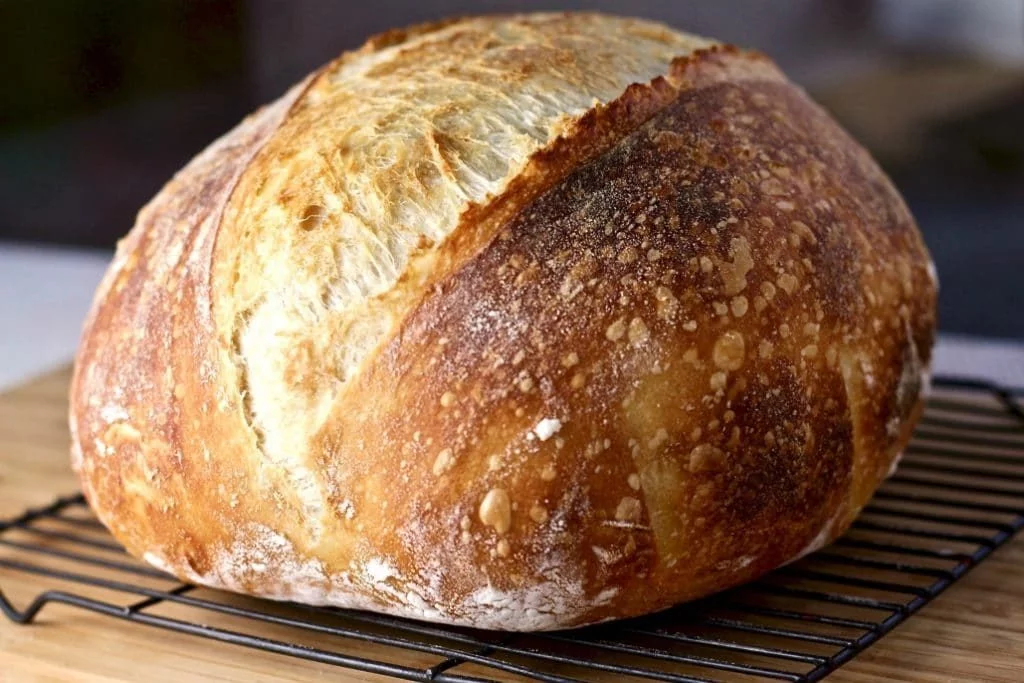
Learning how to make sourdough Artisan bread is a lot to take in. We made a video of the ENTIRE process of making this recipe for you. If it doesn’t Play for you find it Here on our YouTube Channel .
Watch the Video Demonstration:This video compresses the 24 hours it takes to complete this recipe into about 6 minutes. You can accomplish this basic sourdough recipe. And your family will love you for it.
What is sourdough Bread? Sourdough bread is a type of bread that is made through a fermentation process that uses a natural starter culture, rather than commercial yeast. The natural starter culture, also known as a sourdough starter, is made from a mixture of flour and water that has been fermented by wild yeast and lactic acid bacteria. This mixture is then used to ferment the dough for the bread, which gives it its characteristic sour flavor.
Is sourdough a Healthy Bread? Sourdough bread is made through a fermentation process that uses a natural starter culture, rather than commercial yeast. This process can result in a bread that is easier to digest for some people and that has a lower glycemic index than other types of bread. Additionally, sourdough bread is a good source of fiber, protein, B vitamins, and minerals like iron and zinc.
Read My Post on Why Sourdough Bread Is good For you. It goes deep into why sourdough bread benefits your health and should be a regular part of your diet for good health.
This is a basic sourdough bread recipe that uses the long cold rise method. Allowing the dough to ferment in the fridge for 12 to 36 hours will develop the flavor and texture of the bread and allow the fermentation to give you the best health benefits of sourdough bread.
I have had a LARGE number of readers tag us on our various social networks and email me pics of their wonderful results. The best part of my day is seeing your successes.
Learn the techniques used in this naturally fermented bread recipe. Take every step in order and make this beautiful sourdough bread. Let us know in the comments if it helps you out.
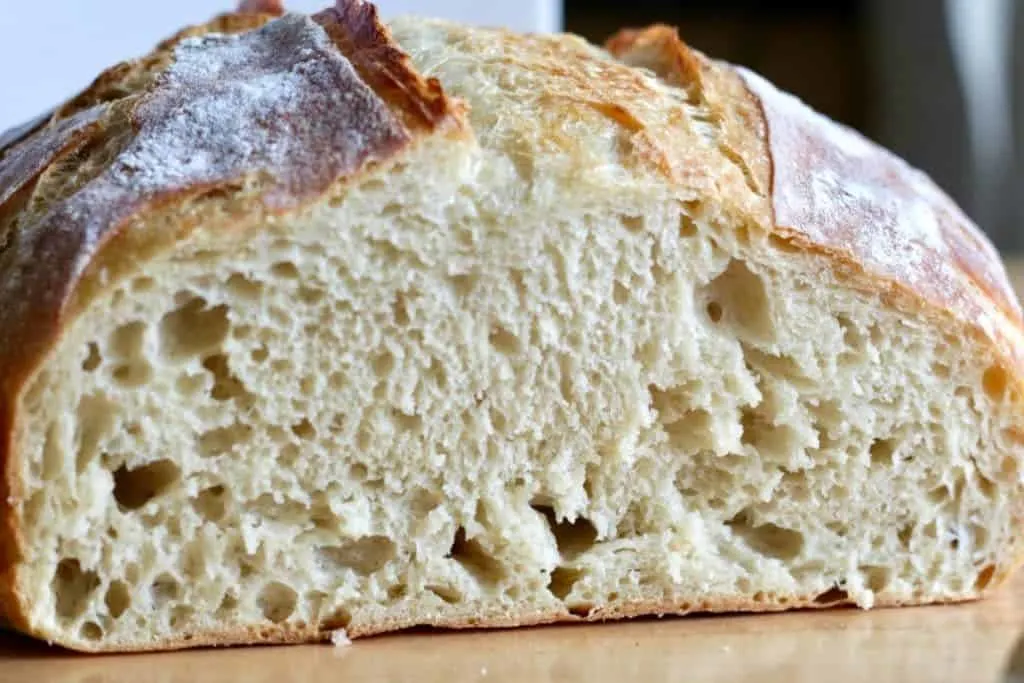
This is a lean bread. Very crusty with a tender, creamy well developed crumb. And only THREE ingredients. Flour water and salt.
Learn this beginner sourdough artisan bread recipe. It will pay you back every time you DON’T buy an artisan loaf from the bakery.
Artisan bread making is a HUGE subject. I will go into as much detail as I can for you here and include resources for you. Feel free to ask your questions. But FIRST PLEASE READ the entire tutorial.
Sourdough artisan recipes with the stretch and fold method and long cold rise are a unique class of bread. Learn the methods to make these breads and you will be a bread baking star in your foodie circle.
Do you need a dutch oven for sourdough bread?
Baking sourdough loaves in your dutch oven provides a way to steam the dough as it bakes. This helps form a crusty loaf with a tender moist center. The dutch oven sourdough bread method keeps the outside crust from becoming too tough during the main baking process. The lid comes off the dutch oven the last 10 or 15 minutes of baking which allows for a crispy crust with a tender bread center.
To ensure proper bread baking you will need to create an environment that captures both steam and maintain heat. There are a few other methods you can try if you do not have a dutch oven.
Use a baking stone to help maintain the high heat needed for proper artisan bread baking. Use a casserole dish or deep roasting dish that can hold in the steam. A deep cast Iron pan with a lid on it can also be used for sourdough bread baking, just make sure that it is tall enough to allow the bread to properly rise. And if all else fails try a cookie sheet with a roasting pan lid over it.
Steam Baking:
The point is you need to create steam around the dough as it bakes. Most ovens do not have a great seal. So spritzing the bread in the oven as it bakes is less than ideal. For the best crust and texture you need constant steam around the loaf while it bakes at least the first 15 to 20 minutes.
That shattered crust and open tender crumb is the Homemade Food Junkie Artisan sourdough goal. Learn this method. There is no going back. And you can do SO many bread varieties with this recipe.
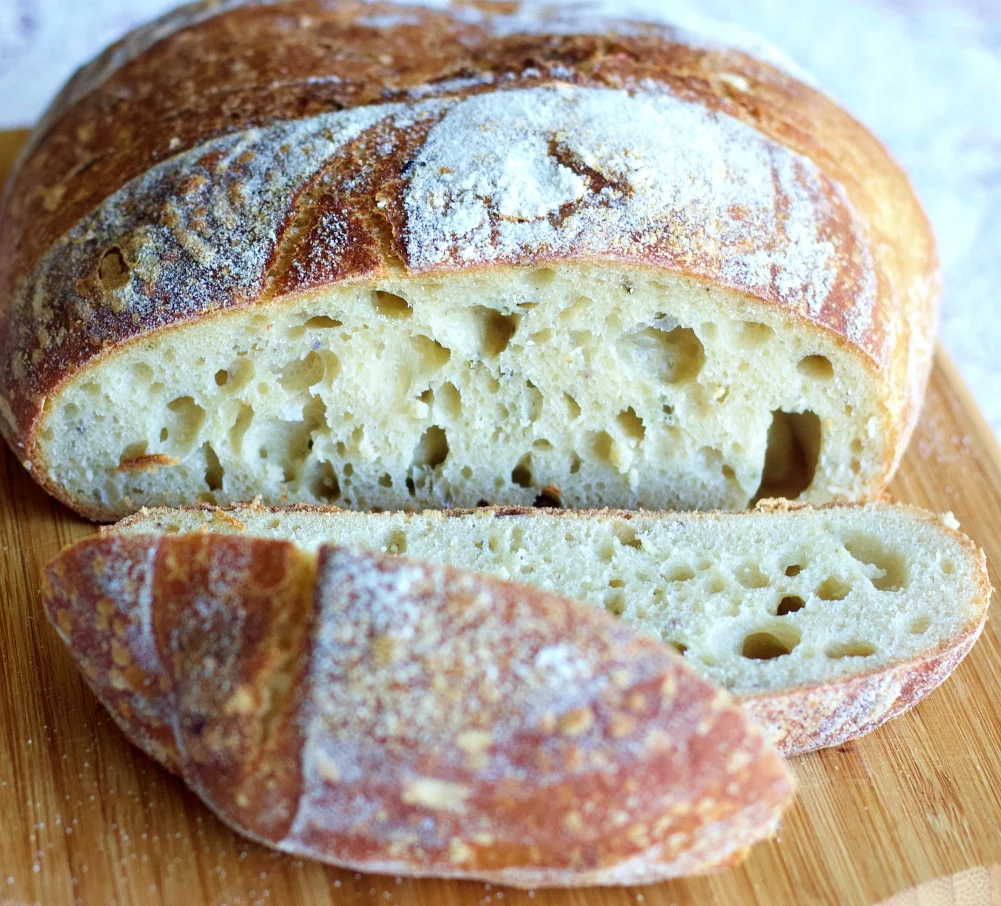
Supplies:
If you make sourdough loaves like this for a while you will get MUCH better results from a few purchases. The crusty flavorful breads are so good. All you need is flour and salt and a few supplies to bake some pretty amazing breads.
- Measure your ingredients by WEIGHT. Flours especially need weight rather than volume measures for the most consistent results. Here’s a decent 22 lb. food scale.
- Salt will have VERY different volumes depending on the variety of salt in your kitchen. I use sea salt for this recipe.
- You will need a dutch oven or other HIGH HEAT (to 500 degrees) oven safe skillet with a lid. Use either a cast iron skillet combo or a dutch oven. Here’s my 6.5 quart Le Creuset oval Dutch oven (gifted to me by my Lovely In laws).
- I am SO happy I bought this dough scraper set . They are VERY helpful working with high hydration doughs. The bowl scraper is genius. This is a sticky dough and the bowl scraper (when wet) slides that dough around like a dream.
- 8.5 inch Bannetons are for the final long rise often done in the fridge. They come with handy cloth liners that fit to help keep the dough well formed. The finished bread has lovely ridges in if you remove the cloth liners and just flour the baskets.
- A lame knife for scoring your loaves. Also really helpful in releasing the dough to rise properly.
- A VERY good starter. You can make and strengthen your own with our tips in this post. OR buy it from our friend Sasha on etsy!
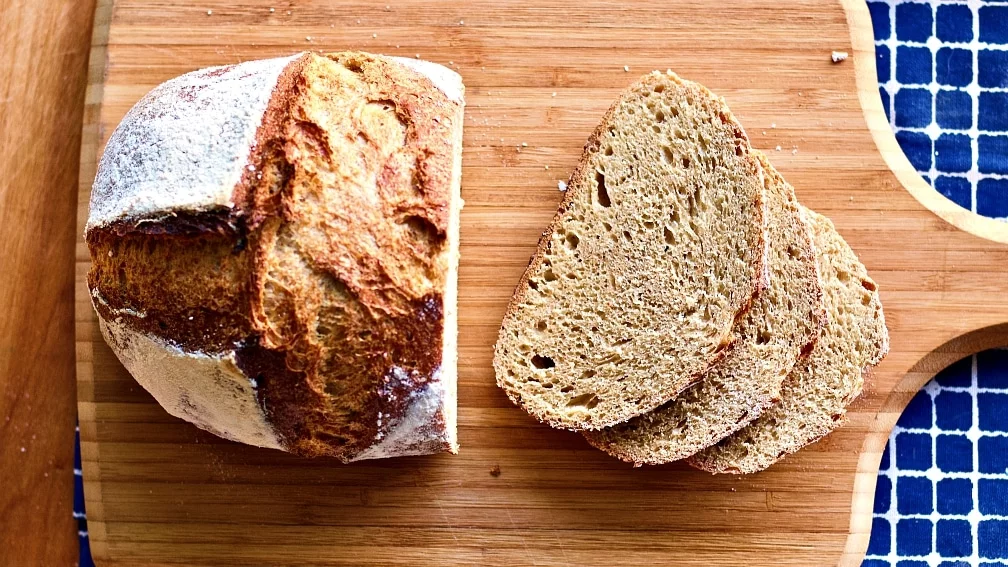
Interested in baking 100 percent whole wheat sourdough bread? Hop over to our post on Beginners Whole Wheat Artisan Sourdough Bread .
I put helps, tips and information into the sourdough whole wheat bread post specific to working with whole wheat flour.
How to Bake Sourdough No Knead Bread:
This is a basic NO KNEAD artisan bread. The 4 stretch and folds 30 minutes apart replace the kneading. This bread does all the work for you. It just takes time.
sourdough dutch oven bread recipe from a wild yeast starter. It uses the long cold rise and the stretch and fold technique we have discussed.
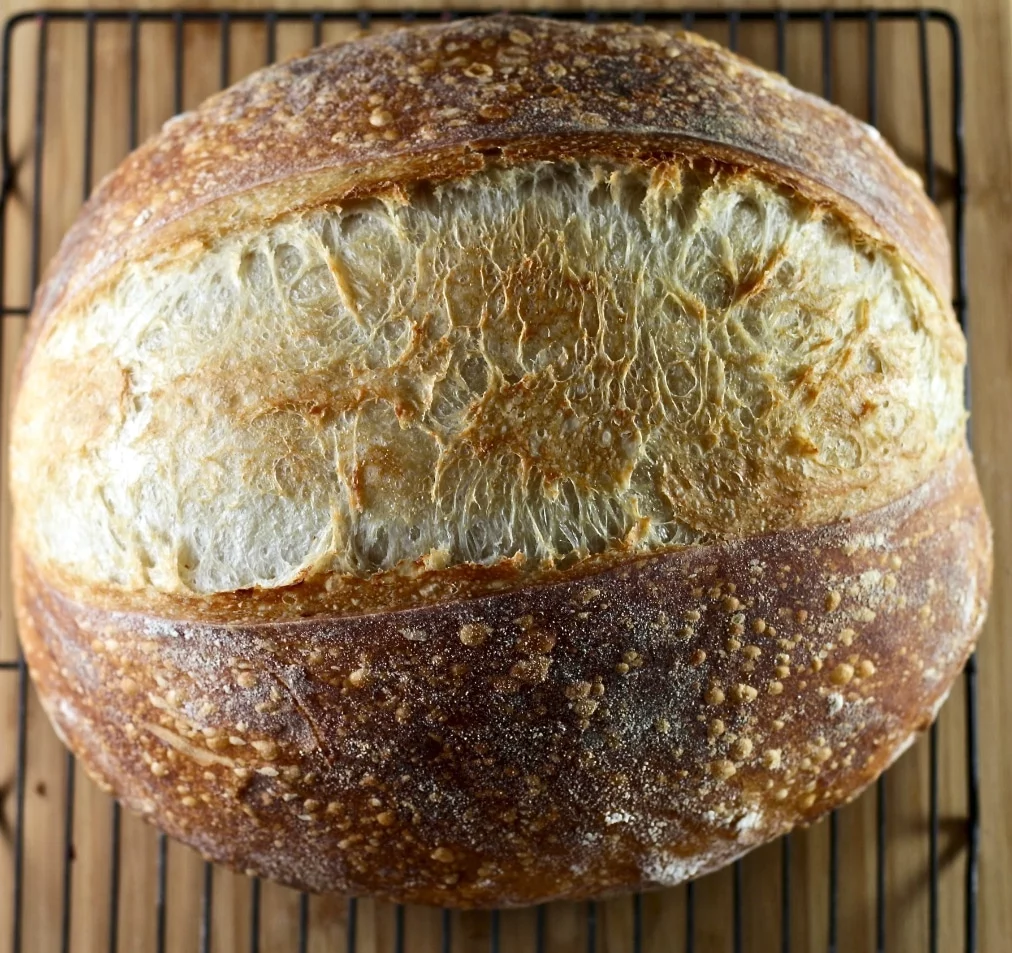
Once you learn how to make Sourdough bread a whole new baking world will open for you.
Use a very active wild yeast starter. Learn How to make Wild Yeast Starter in this post.
- Wild yeast starters provide a much Better, Fuller, more Complex….AMAZING flavor and texture than commercial yeasts can. You can easily build your own wild yeast starter. But plan ahead.
- Give yourself about a week to get it ripe and bubbly.
Sourdough recipes with starter require a VERY active Starter. You can use any starter recipe you prefer IF it can pass the float test. MOST important for a good rise in your loaf.
Where can I buy a Sourdough Starter?
You can purchase a sourdough starter on the online if you do not have one on hand. The other option is to make your own. However, established sourdough starters are a great option to make delicious bread quicker. We have purchased this sourdough starter on Etsy and have used it with great results.
This starter is very tangy. It is local to the San Francisco area and definitely is more of a San Francisco sourdough bread flavor.
How much Sourdough Starter is needed for a loaf of bread?
You will need 100 grams of active sourdough starter to bake one loaf of bread. This recipe calls for 200 grams of sourdough starter and yields 2 loaves of artisan bread.
Balancing Your Starter:
Feed your starter 1:1:1 and bring it back to the float test. I feed my starter the night before I want to bake.
- 100 grams starter-unfed or recently fed-room temperature
- 100 grams flour
- 100 grams warm water
Now let it ferment several hours to overnight to return the starter to the float test. This process is a simple way to ensure your active sourdough starter is properly balanced for bread baking.
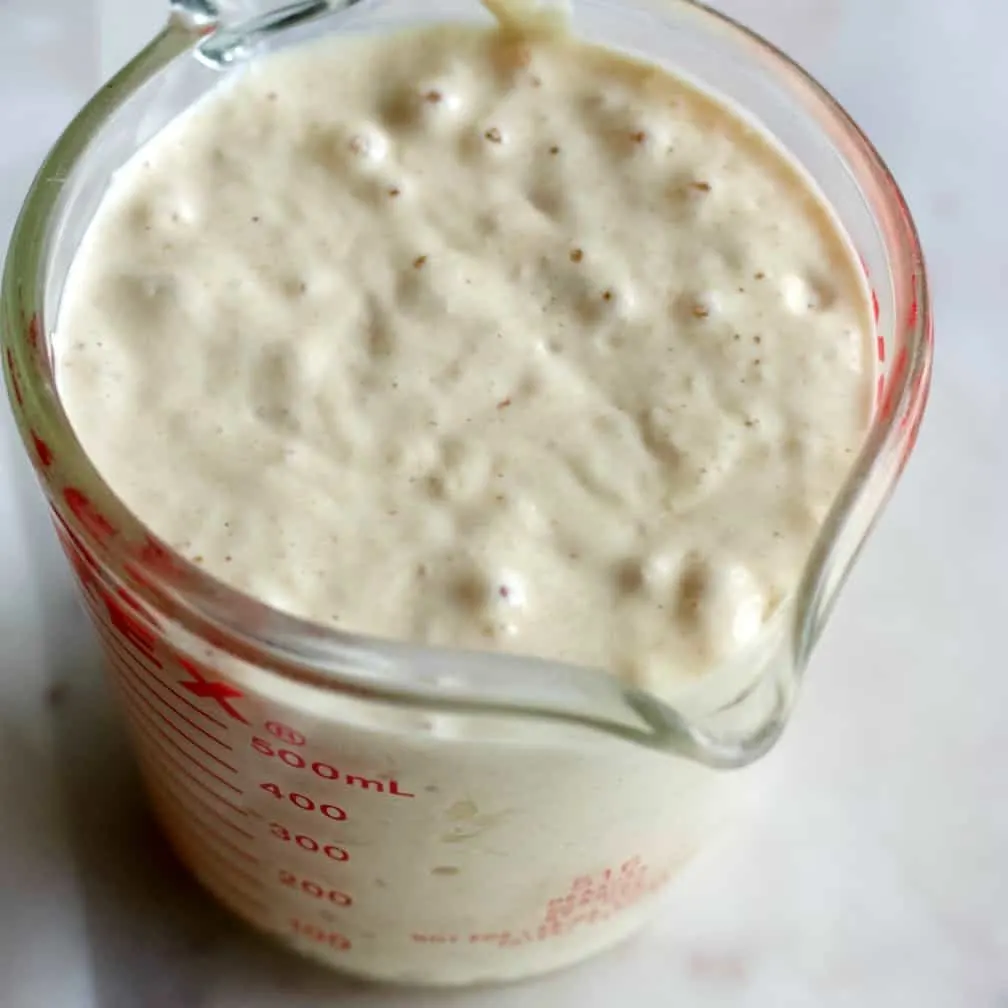
The float test:
If you take a teaspoon or so of starter and drop it in a cup of room temperature water it will float when it’s ready to make bread.
If your starter does NOT float. Feed and balance it as I describe above and try again after several hours to overnight.
After the starter is active like this one, (and floats firmly in a cup of water) it’s time to bake bread.
Use high protein bread flour:
When I started making sourdough I used my all regular all purpose flour. The bread was delicious BUT it did not give me the form or the rise I prefer.
I was schooled on this by our contributor Sasha Hunter our bread baker extraordinaire friend.
Sasha recommends King Arthur bread flour or high protein flour All purpose Montana White flour. What a difference in my loaf rise! Look for flour the is over 12% protein or 5 grams protein on the label.
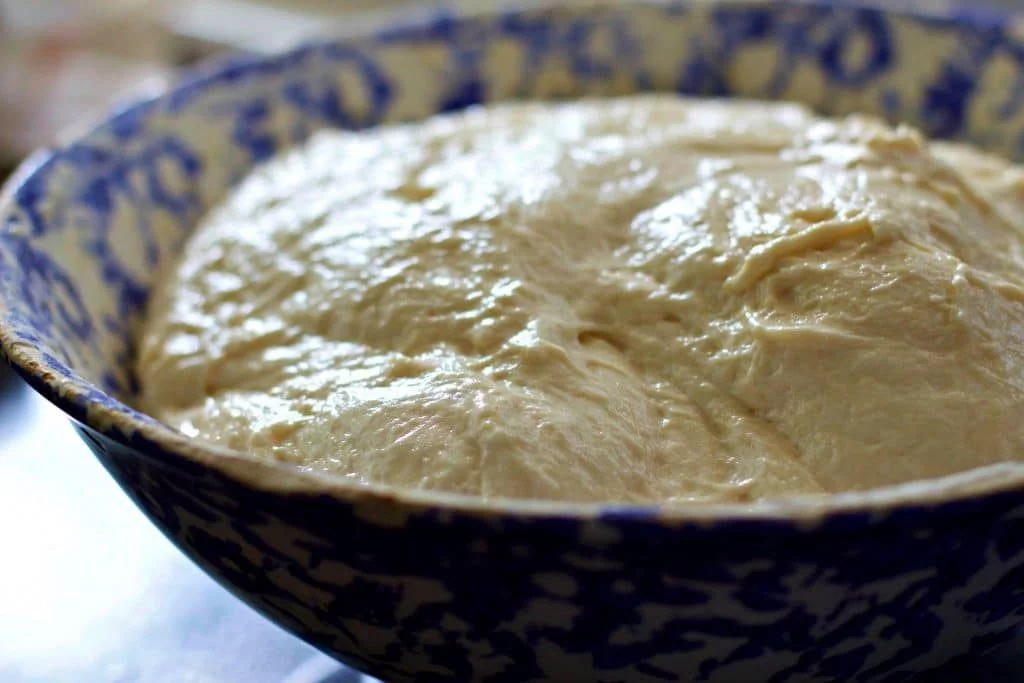
More Helpful Tips:
- Expect the dough to be sticky:
- WET HANDS really help when handling this dough. The stretch and fold process transforms the dough from a sticky shaggy mess to a workable dough. But it will always be slightly sticky with 100 percent white flour and High hydration.
- MEASURE YOUR INGREDIENTS BY WEIGHT FOR BEST RESULTS:
- Your climate, flour type, season of the year…all sorts of stuff changes the way a bread baking recipe works. This is especially true of this type of bread.
- High hydration loaves can be tricky. Help yourself out and weigh the ingredients. WEIGHING is best for consistent results.
- Begin with a healthy leaven (your wild starter) that bubbles and floats in a cup of water. (More on that below.)
What is Autolyse? (resting stage):
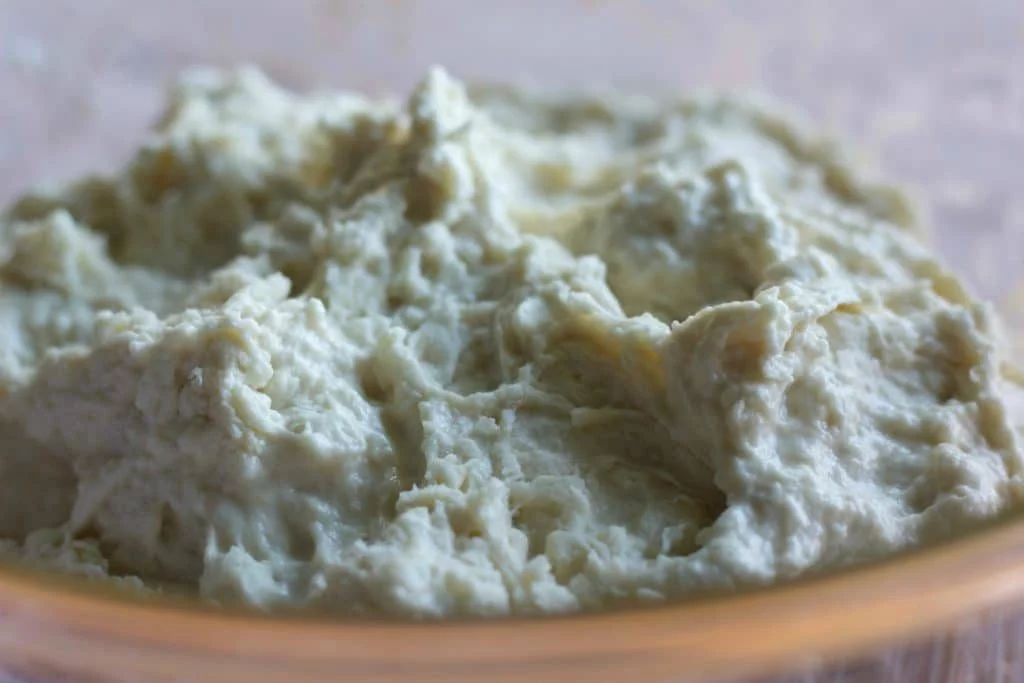
This is done immediately after you mix your starter, flour and water. The purpose of this passive process is to fully hydrate your dough.
Autolyse 60 minutes. it’s Important for complete dough hydration and good fermentation- you can rest the dough up to four hours. Do NOT skip this step.
REMEMBER Temperature affects ferment rate.
- Keep the dough at around 70 to 75 degrees F. for the bulk rise.
- Some flours are easy to over ferment and other flours need a warmer temp (Not too warm though) to get properly fermented.
- Learn your dough as you handle it. Watch it go through the stages. If it gets slack and won’t rise the dough might be over fermented. (pizza!)
The stretch and folds replace kneading in this recipe. Making sourdough bread no knead makes it simpler and less likely you will overwork the dough. In my opinion, the bread texture is significantly improved with the no knead method of sourdough bread making.
Your Dough should pass the windowpane test. Which means when you stretch the dough it’s pliable and stretches thin enough you can see light through it.
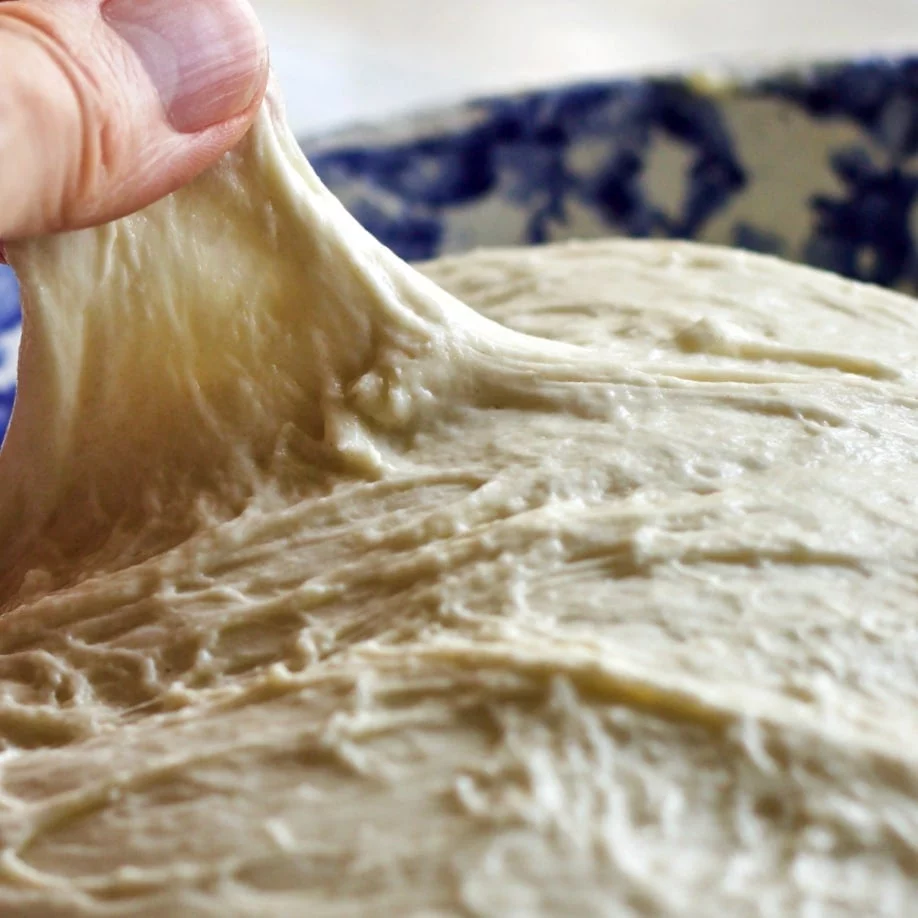
The Final Rise.
- Cold temperature (below 55 degrees F- I use my fridge temperatures) and long rise (12 to 24 hours) give the dough a chance to develop better texture and flavor in the final rise.
- I have made this bread with a four hour final rise and also a 36 hour long cold rise. It all impacts the results. I do notice an improvement in the dough structure with the overnight rise.
NOTE: I sometimes cheat on this recipe by fudging the rise times or reducing the other steps. Life happens 🙂
However, The results DO vary. For best results FOLLOW the directions and keep to the timetable for every step. As you gain experience with this recipe your hands will learn the dough. Then you can play around with it and still get good results.
Shaping your dough:
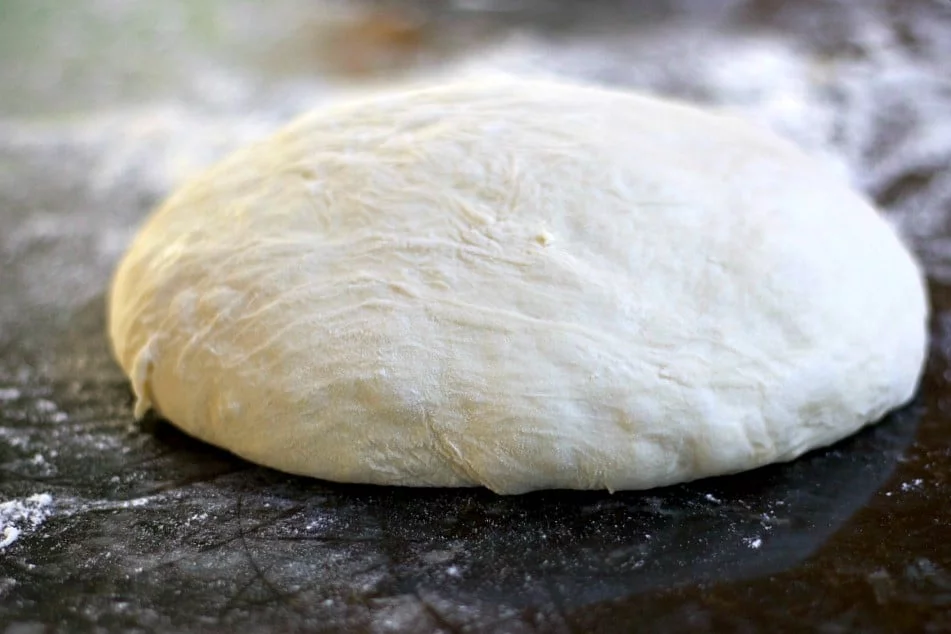
Learning how to properly form your dough into loaves is one KEY to building the rise in your loaves.
- To have a open crumb you have to be very gentle when handling your dough in these final stages. The dough is full of air.
- You want to retain those bubbles in your dough as you work.
- It’s all about keeping the dough arated while you work it and building tension in the surface of the dough.
TIP: Please watch the video and look at how I pull the loaves around to keep the surface tension of the loaf while shaping the boules. This is key to building a good rise.
Making Sourdough Bread in bread pans
You might prefer an even crumb baked in a loaf pan for sandwich bread. Here are the steps.
Shaping dough for bread pans:
- I use two 9 x 4 oiled bread pans.
- After the final rise roll the dough into a rectangle so all the gasses are deflated.
- Fold the wide sides of your rectangle to the middle.
- On ONE end fold the corner to the middle seam making a point.
- Roll your loaf up from the point to the other end.
- Pinch the seams and ends.
- Place in oiled bread pans.
- Rise at room temperature until the dough is at the top of the pans.
IF your dutch oven is large enough put the loaf pan right in the dutch oven and cover it. Bake as directed. Works great!
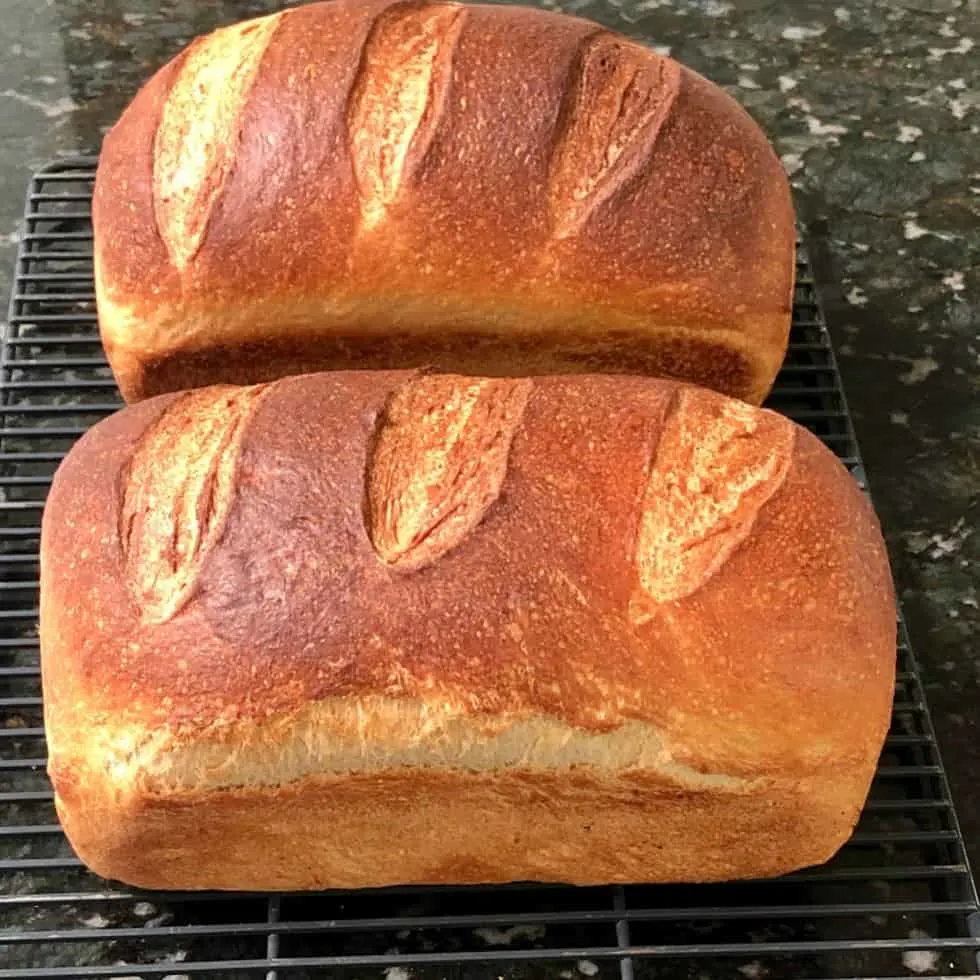
Baking sourdough hearth breads in bread pans:
- If you have a large dutch oven bake one loaf at a time in it. Follow the directions in the recipe card.
- If you cannot fit the bread pans into your dutch oven place them on a cookie sheet.
- You will also need a lower heat. Preheat to 400 degrees F. for 15 minutes. Reduce heat to 375 and bake another 30 to 40 minutes.
- On the shelf below the pans fill a pan with water (like a roasting pan) for steam.
- Spray your unbaked loaves liberally with water before setting them in your hot oven.
- follow the recipe instructions. Do the thump test to make sure they are done.
Sourdough Bread Recipe with Starter is very different from other yeast bread recipes.
Cooling Your Loaves:
You MUST resist cutting your divine smelling sourdough bread until it’s room temperature all the way through. Why?
- Your loaves are still baking and developing the crumb and crust even as they cool.
- Do you hear the ‘bread music’? Bread music is the crackling sound your crust makes as it cools. This creates a shattery artisan crusty loaf. Let it happen!
- Inside your bread the crumb is also going through its finishing touches. The crumb is setting.
- If you cut your bread when it’s still piping hot you will squish that gorgeous loaf. The crumb will be crushed and your experience with your sourdough artisan bread will disappoint.
- Cut your cooled loaves with a GOOD sharp serrated knife. The crust will be crusty. A good knife will penetrate the crust and NOT squish the tender crumb.
If you print the recipe the pictures will not print. This is to save you paper and ink.
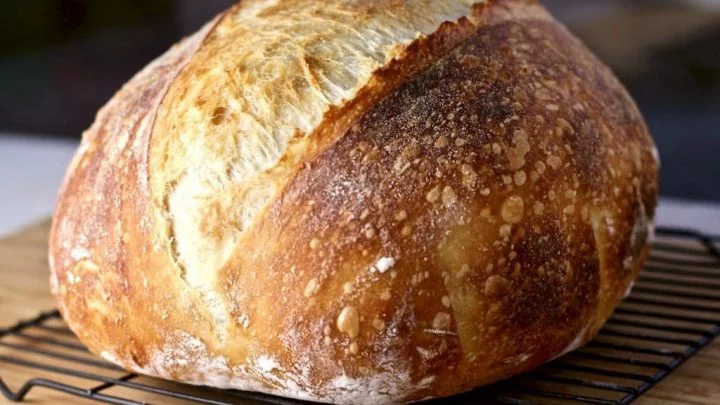
Beginners Artisan Sourdough Bread Recipe
Make your own delicious bakery quality artisan sourdough breads at home. This recipe is a good start for new sourdough bakers. It's a long process but an easy one. These breads are so worth it!
Ingredients
For the Dough:
- 525 grams water-80 degree F. -NO chlorine, 2.22 Cups
- 20 grams salt OR 1 Tablespoon MAX. (different salts might weigh out differently. They will also have different volumes so don't go overboard.)
- 200 grams Very active starter - make sure it floats , 1 + Cup
- 700 grams All purpose Flour (or bread flour), 5 1/2 Cups
Instructions
MAKE THE STARTER:
- Make the STARTER AHEAD
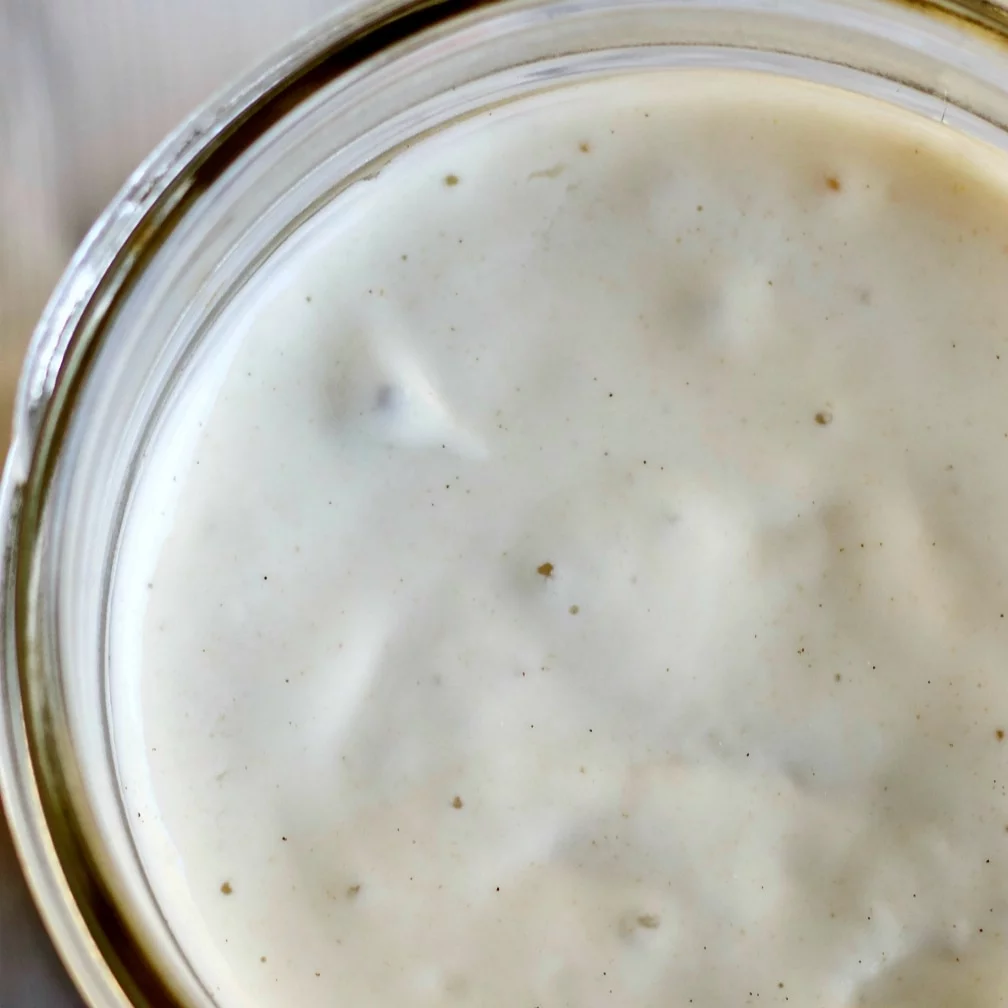 (This can take up to a week or more) AND DO NOT USE UNTIL IT IS ACTIVE ENOUGH TO FLOAT A TEASPOON ON A CUP OF WATER.
(This can take up to a week or more) AND DO NOT USE UNTIL IT IS ACTIVE ENOUGH TO FLOAT A TEASPOON ON A CUP OF WATER. 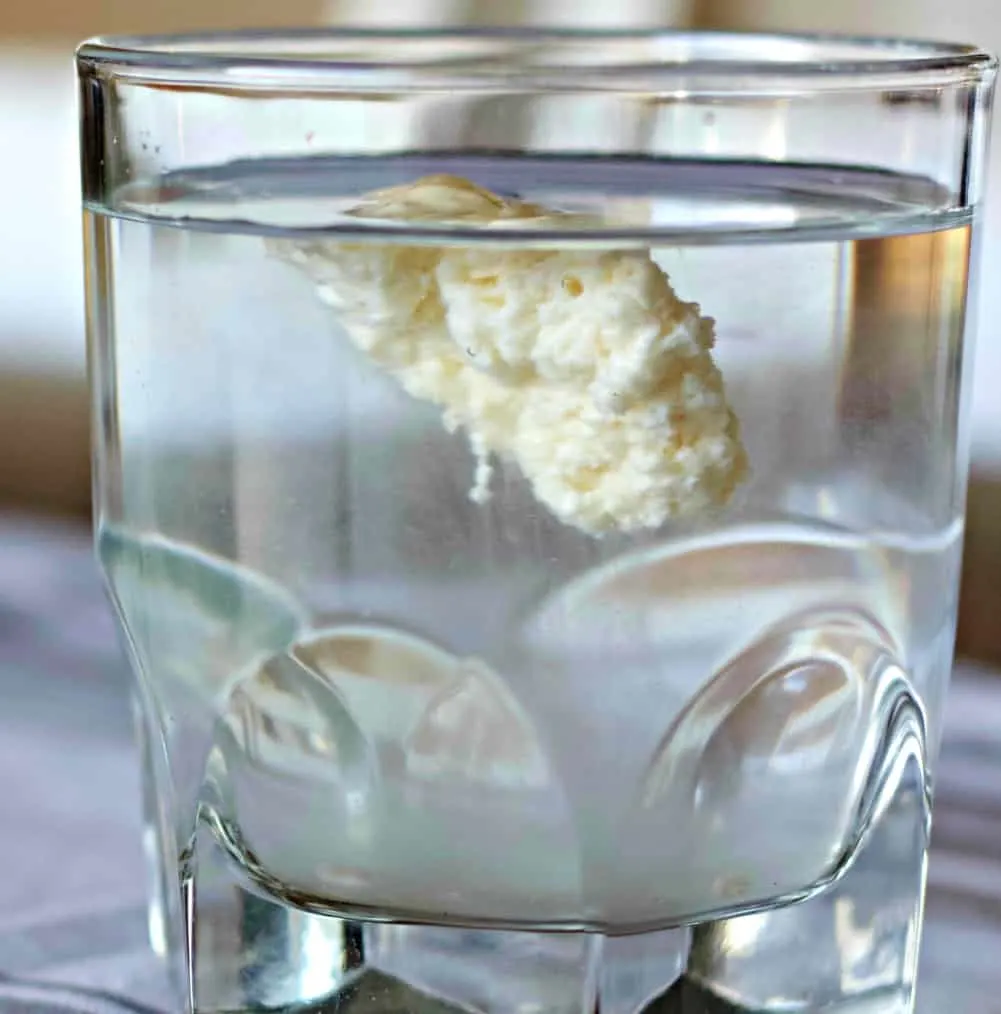
Prep the Starter For Baking:
- This process balances your starter for best rise. Feed 100 grams starter with 100 grams flour and 100 grams warm water.
- Let sit overnight.
- It should pass the float test in 8 to 12 hours.
- If it does not repeat feeding.
MIX THE DOUGH:
- Pour the water into a large bowl.
- Add the ripe balanced starter to the water and mix thoroughly with a whisk or by hand until the floating cloud of starter is mixed completely into the water.
- Add the flour to the leavened water and mix with the dough bowl scraper or other spatula. At the end use wet hands to form a shaggy dough ball.
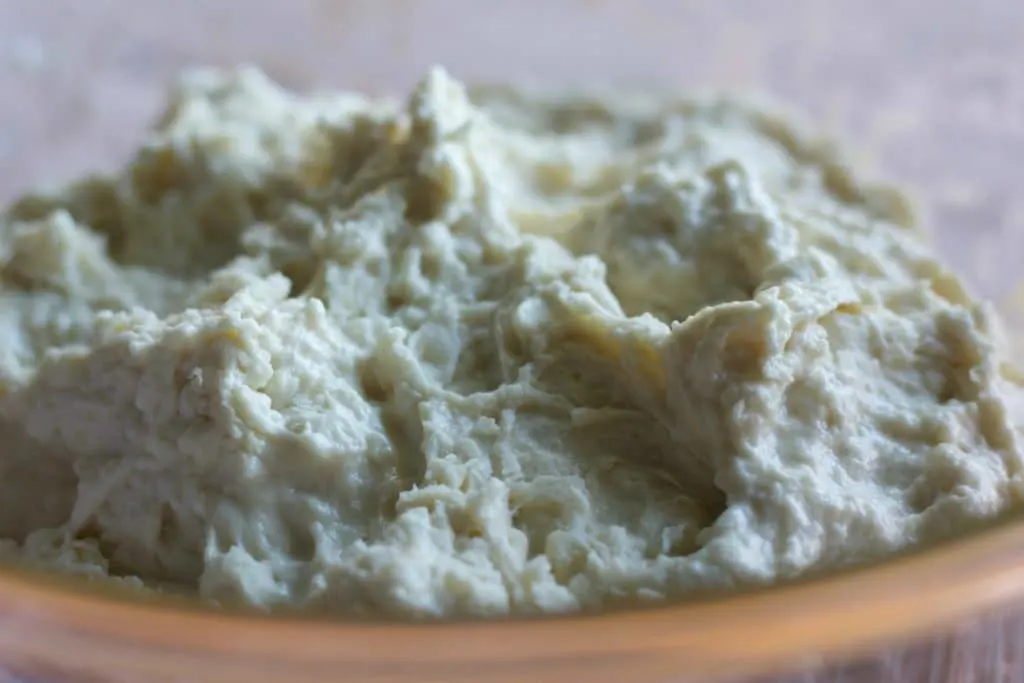
AUTOLYSE:
- Let it rest (autolyse stage) about an hour. This stage can be extended without worry up to four hours.
- After autolyse, add the salt to the bread dough. Use your hands to pinch and stretch the dough gently until the salt is mixed into the dough.
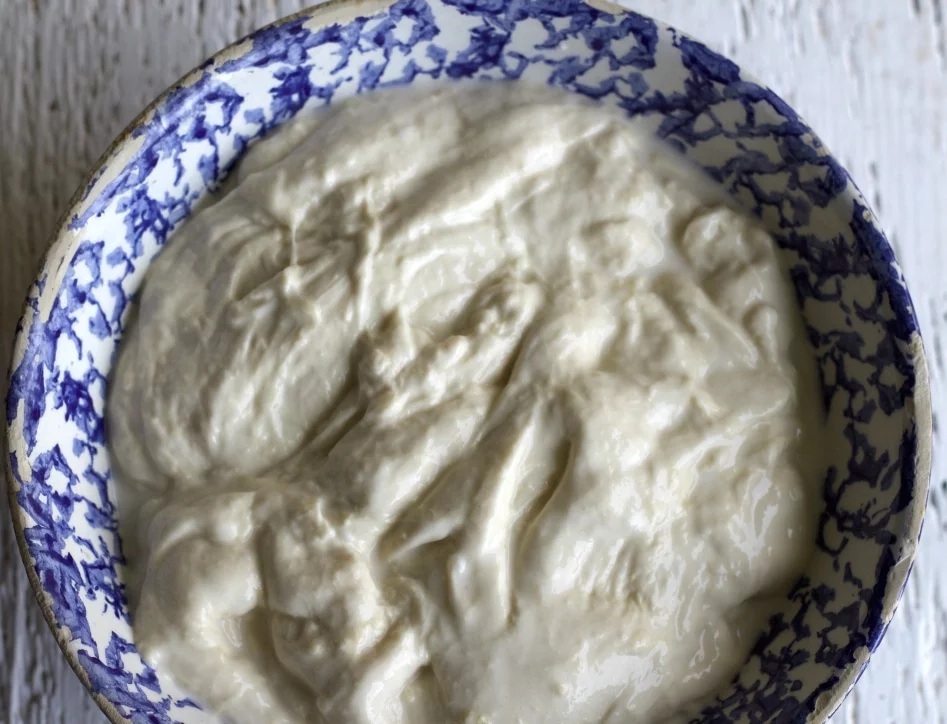
Stretch and Fold:
- Using your wet hands pull the dough from under the dough ball up and stretch it gently as you pull it over the dough ball top. Release. Repeat this process as you give the bowl quarter turns until the dough is stretched and pulled from each quarter of the bowl.
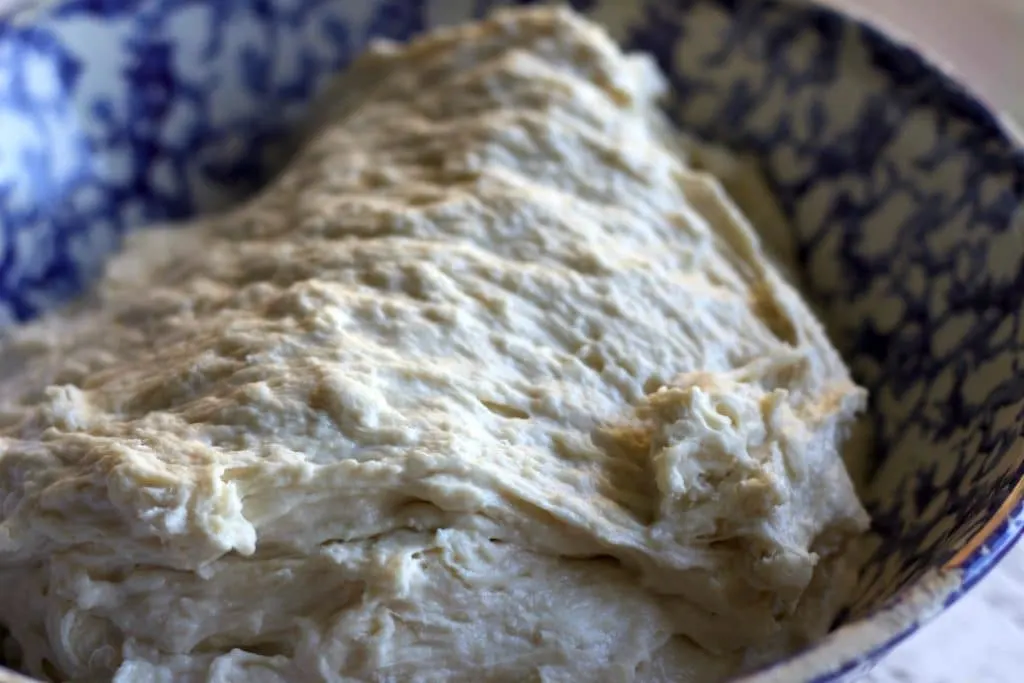
- Over the next 2 1/2 hours repeat the stretch and fold every 30 minutes for a total of FOUR times. The dough will change from a slimy ropy mass to a billowy dough with many air pockets and definite body as you stretch and fold it. DO NOT PUNCH DOWN THE DOUGH AT ANY TIME. Those air bubbles create the excellent crumb and flavor.
- The dough should become an elastic resilient dough that passes the window pane test. IF your dough is still breaking before it goes transparent when pulled. Do ANOTHER stretch and fold.

BULK RISE:
- Allow the dough to bulk rise IN THE BOWL at room temperature an hour or SO until it rises by 30 percent or so.
- Cover the bowl of dough with a plastic bag and set it in the fridge for 12 to 15 hours (Or overnight). It should continue to rise slowly so give it room in the bowl.
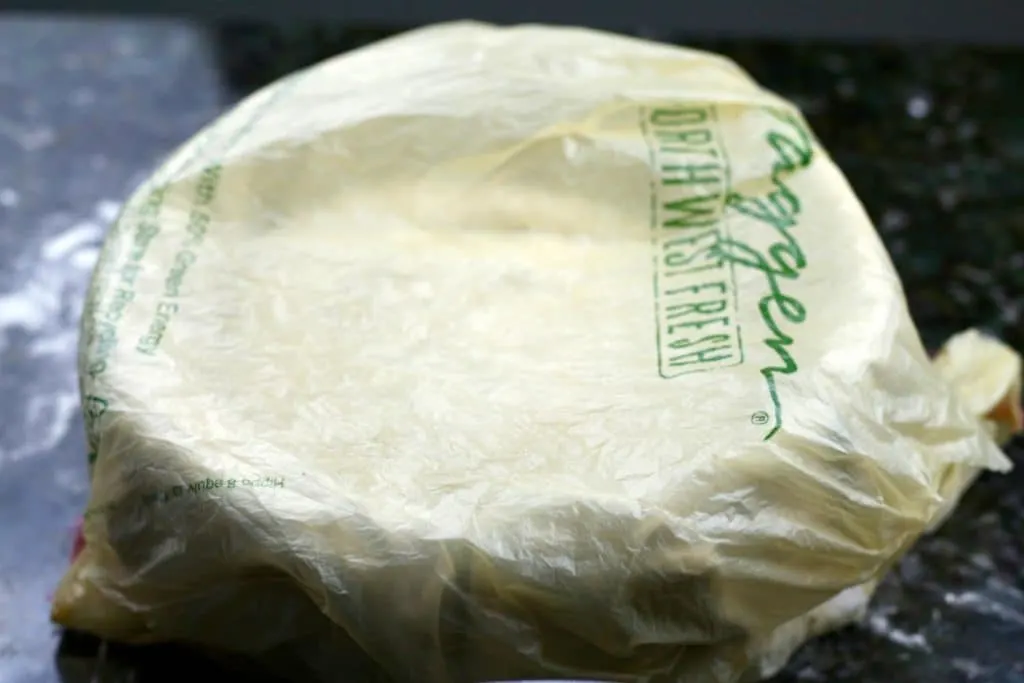
- Remove the dough from the fridge and let it sit on the counter in the bowl for two hours or until the dough reaches room temperature (or pretty close). The dough will soften and gently rise (a tiny bit) as it warms.
DIVIDE AND BENCH REST THE DOUGH:
- On a clean unfloured counter pour out the dough into a large mass. Flour the top of the dough lightly but evenly.
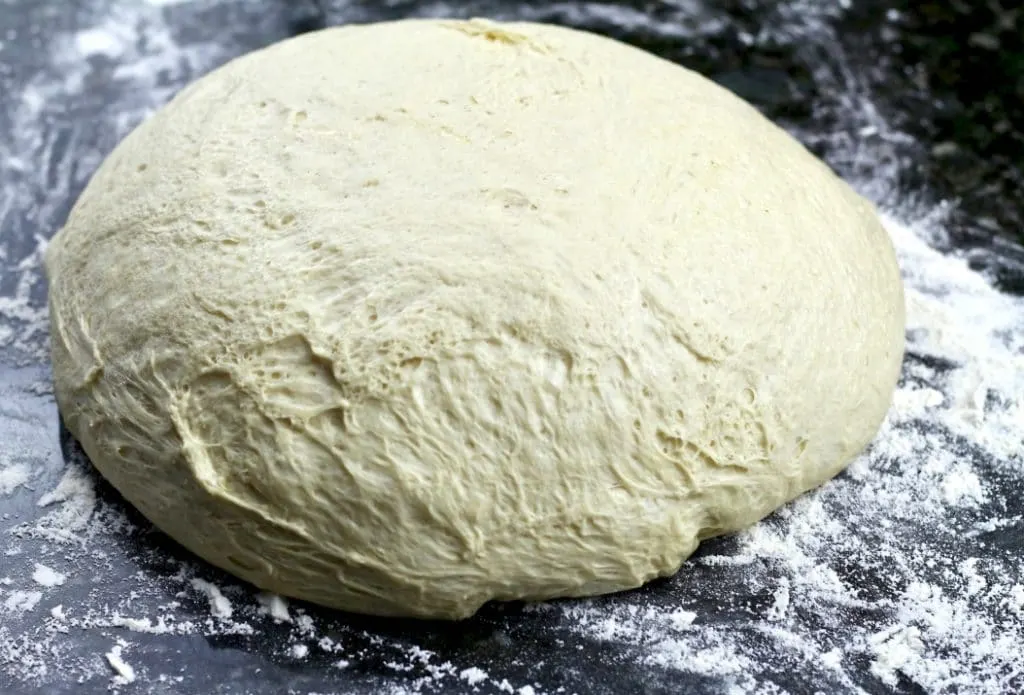
- BEING CAREFUL NOT TO OVERWORK THE DOUGH-Form each half into a dough ball. The most efficient way to do this is to use the counter as your pivot point. Scrape in a circle around the dough (leave it unturned, flour side up). The unfloured counter will hold the dough center and create tension as you circle the dough with the scraper forming a ball. Repeat to form two dough balls. The DOUGH edge should be round and the dough ball should have some form and resilience to it.

- Let the dough balls rest for 20 to 30 minutes. They will spread out but should not fall off at the edge of the pancake. If they do, reform the loaves and bench rest them again to build the structure of the dough better.
FINAL SHAPE AND RISE:
- Gently slide the dough scraper under one of your dough balls and flip it over so it rests on the floured side.
- Now gently stretch and pull the dough over from the bottom to 1/3 up the loaf. Stretch and pull the dough from the sides to the dough middle. For the final stretch take the dough from the top of the ball and pull it all the way down to the bottom. Form a seam. Pinching the seam as necessary. (view the video for help here)
- Place the dough seam side up in your rice floured, cloth lined banneton or bowl.
- Rise in the fridge 2 to four hours.
Baking Instructions:
- Set a baking stone (if you have one) on your oven bottom rack. Set your dutch oven with it's lid on next rack up (lower third of oven). PREHEAT oven to 450 degrees F. for at least 30 minutes.
- Keep the formed loaf in your banneton in the fridge until you actually need to place it in your preheated dutch oven. Cold dough will aide the oven spring.
- Remove one banneton from the fridge. Place the dough in your preheated dutch oven. I do this by flipping it into the dutch oven as gently as possible seam side down.
- Alternate method: Place high heat safe parchment paper over the banneton. Turn the banneton upside down so the dough falls gently onto the parchment paper.
- Score the loaf with your lame knife or a razor blade or sharp scissors. Scoring helps the dough rise better.
- Now pick up the scored loaf with the edges of the parchment paper, if using, and gently and carefully place it into your VERY hot dutch oven.
- Put the lid on the dutch oven and return it covered to your preheated oven.
- Bake 30 minutes at 450 degrees.
- Now REMOVE the lid (and parchment paper if using). Steam should come out. Hopefully the bread is a light golden color with a nice rise and set crust. Bake an additional 10 minutes UNCOVERED or until the loaf thumps hollowly and the surface gets dark(Caramelized darker than you are used to maybe) and the scored areas look shiny. (To prevent over browning turn the parchment paper (or foil) upside down over the loaf as it finishes in the oven.)
- Remove the dutch oven. Place the finished loaf on a cooling rack. Do NOT cut it for at least an hour to set the crumb.
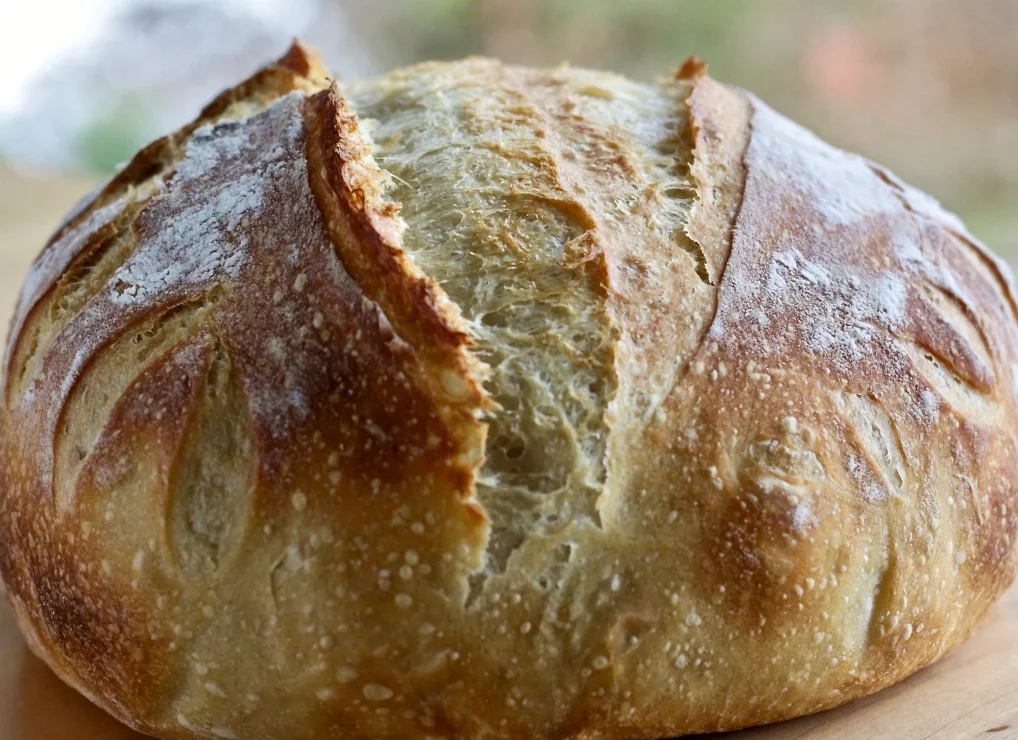
- Return the dutch oven (with lid on) to the oven at 450 degrees F and preheat for 15 minutes. Repeat the process with the remaining loaf.
- To tell if your bread is properly done. Use your digital thermometer and insert it into the center of the loaf. It should read about 205 degrees.
- Other TELLS: Look at the crust and LISTEN to it cool. The crust should be 'shattery' which means as it cools it will crack. You can see it and hear it. This is bread music 🙂 also a dull sounding bread is probably not completely baked. When you cut the loaf is should have a creamy but springy crumb with lots of aration.
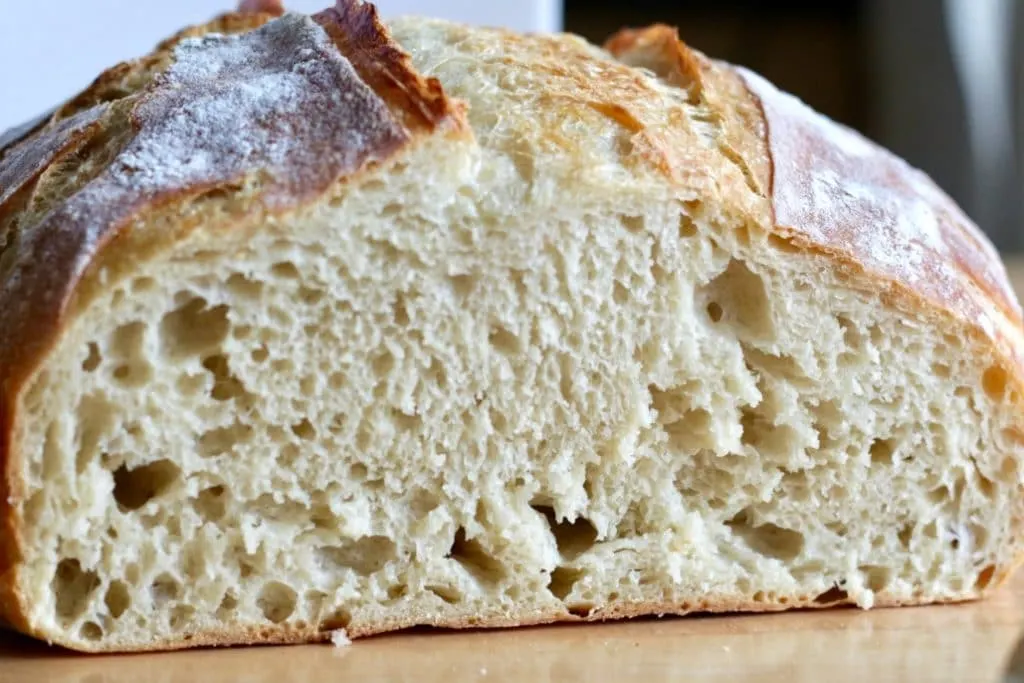
Notes
TIPS:
- WATCH your dough as it goes through the stages of fermentation. This dough can easily over ferment at high room (Or oven proofing) temperatures. If your dough gets slack, unworkable and won't form or rise it is probably over fermented. At this point I suggest you Make pizza with it instead of loaf bread 🙂
- To avoid over fermentation keep the room temperature (or oven) at 80 degrees or less. Whatever flour you are using will influence this process. Learn to work with the dough you are creating.
Freezing:
- This bread freezes VERY well. After it is completely cooled double wrap it tightly with plastic wrap and set in the freezer. I have done this several times. Defrost at room temperature wrapped or unwrapped. Slice and eat.
Storing the loaves:
- For best results store your sourdough bread loaves in a bread box (I use my dutch oven with the lid slightly cocked). That beautiful crunchy Sourdough crust gets soft in an airtight container or plastic sack. Once cut just set the bread cut side down to protect the crumb. These loaves hold very well for at least three days. Freeze the other finished loaf if you can't eat it right away.
Banneton Tips:
I am using my ceramic round bowls lined with linen dish cloths for my bannetons. The high hydration doughs like these tend TO STICK to those cloths. To help with I scrub rice flour into the cloth. And leave an extra bit of it in the banneton bottom. Once the dough is in the banneton I add a bit more rice around the side of the loaf to keep it from sticking during the rise.
IF your dough sticks a bit to the banneton cloth, use a sharp knife to pull it away and add some rice flour to the sticking spot. Now it should invert without too much trouble. For really tough sticks, cut the dough away and repair it carefully by pressing it to reshape it before baking. Careful of burns if you are doing this in a hot pot.
Baking sourdough hearth breads in bread pans:
- If you have a large dutch oven bake one loaf at a time in it. Follow the directions in the recipe card.
- If you cannot fit the bread pans into your dutch oven place them on a cookie sheet.
- You will also need a lower heat. Preheat to 400 degrees F. for 15 minutes. Reduce heat to 375 and bake another 30 to 40 minutes.
- On the shelf below the pans fill a pan with water (like a roasting pan) for steam.
- Spray your unbaked loaves liberally with water before setting them in your hot oven.
- follow the recipe instructions. Do the thump test to make sure they are done.
Recommended Products
As an Amazon Associate and member of other affiliate programs, I earn from qualifying purchases.
-
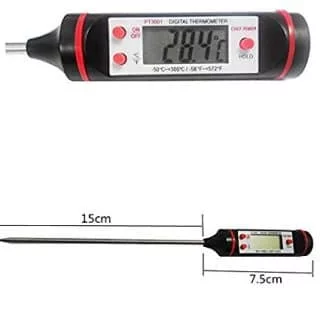 Chef Rimer Meat Thermometer Long Very Fast Accurate Instant Read Temperature Digital Food Probe For Cooking Grill Camping BBQ Candy Yogurt Dairy Beer Bread Milk Liquid With Battery
Chef Rimer Meat Thermometer Long Very Fast Accurate Instant Read Temperature Digital Food Probe For Cooking Grill Camping BBQ Candy Yogurt Dairy Beer Bread Milk Liquid With Battery -
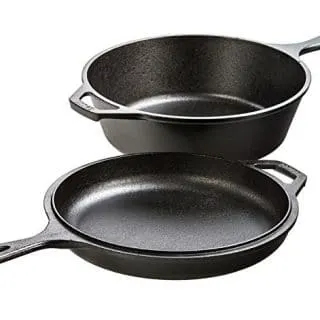 Lodge LCC3 Cast Iron Combo Cooker, Pre-Seasoned, 3.2-Quart
Lodge LCC3 Cast Iron Combo Cooker, Pre-Seasoned, 3.2-Quart -
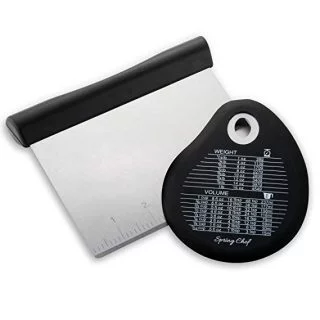 Spring Chef Stainless Steel Pastry Scraper/Bench Scraper Chopper, Best as Pizza and Dough Cutter
Spring Chef Stainless Steel Pastry Scraper/Bench Scraper Chopper, Best as Pizza and Dough Cutter -
 Le Creuset Signature Enameled Cast-Iron 7-1/4-Quart Round French (Dutch) Oven, Cerise (Cherry Red)
Le Creuset Signature Enameled Cast-Iron 7-1/4-Quart Round French (Dutch) Oven, Cerise (Cherry Red)
Nutrition Information
Yield
24Serving Size
1 sliceAmount Per Serving Calories 104Total Fat 0gSaturated Fat 0gTrans Fat 0gUnsaturated Fat 0gCholesterol 0mgSodium 324mgCarbohydrates 22gFiber 1gSugar 0gProtein 3g
More Sourdough Artisan Bread Recipes:
These breads all turn out perfectly when you follow the instructions. After you gain experience feel free to go your own way with techniques and recipes. Please share with us your successes!
- Milk and Honey Sourdough Sandwich Bread
- Rosemary Garlic Sourdough
- Whole Wheat Sourdough
- Walnut Cranberry Sour-dough Bread
- Oatmeal Sour-dough Bread
- MultiGrain Sour-dough Bread
- Sourdough Banana Bread with Blueberries
These gorgeous dutch oven breads are so flavorful and crusty.
Follow Us:
We enjoy meeting you on our social networks. Follow us on Facebook, Pinterest, Instagram . Tag us with your pictures of our recipes and comment on how it went for you. We would love to see what you do with them.
We often like, comment and share your posts of our recipes on our daily Instagram stories.
Ask questions and rate the recipe in the comments section below. Please share what you did with this recipe. We are always looking for more and better ways to make homemade food. Other cooks love your ideas!
Recent Posts:
We love to see our baker’s results with this recipe. Be sure to share pics on Instagram and tag me in them. We like comment and occasionally share your pics of our recipes on our stories.
Resources:
These books all were very helpful to me. They are probably available in your local library but make valuable resources to keep on hand. Make your best sourdough bread recipe by getting information and experience.
Books:
- Tartine By Chad Robertson
- Tartine 3 By Chad Robertson
- The Bread Baker’s Apprentice by Peter Reinhart
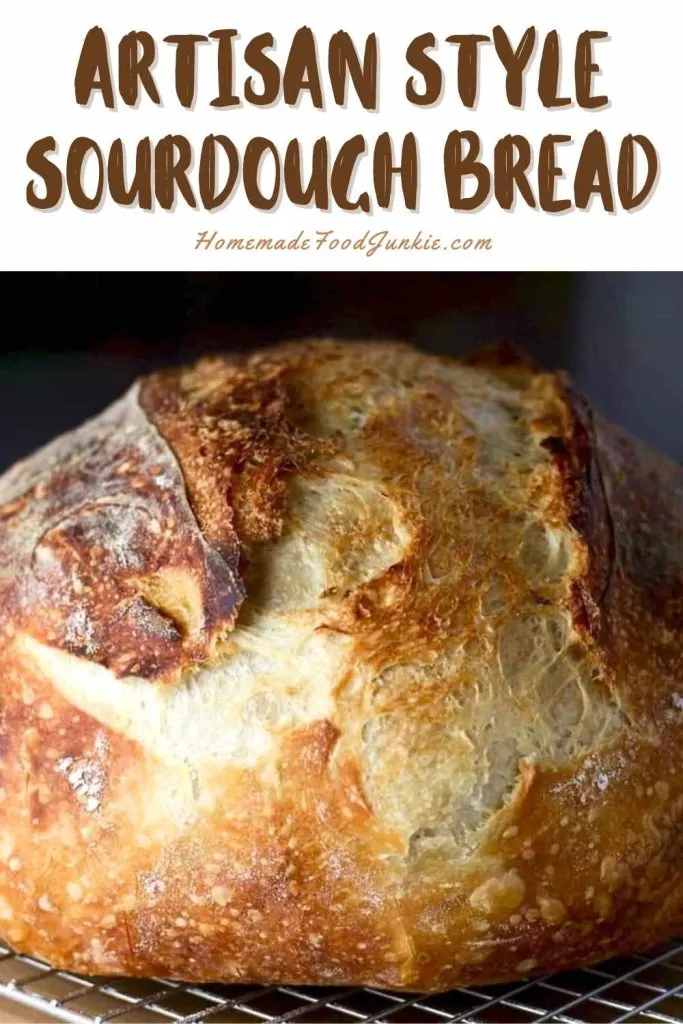

Nicole Tinahui
Saturday 18th of May 2024
Hello, I’ve been making this bread for a few months now following all the instructions and it’s turned out so so good! However this last couple times My bread has over proofed without changing anything. Maybe because it’s getting warmer outside, I’m not sure what steps to change to help this problem
Kayti Lavergne
Saturday 18th of May 2024
Hi Nicole! Yes, warmer weather will definitely make a big difference in proofing time. I would decrease one of the proofing times by 30 minutes and see how that turns out. It's a tricky balance baking it in the hot summer
G
Friday 17th of May 2024
Could use some advice. My starter is strong and active, I’m following the weight amounts of the recipe with fresh bread flour and bottled tap water. My loaves are baking and coming out flat. Is it over proofed or under proofed? Otherwise the bread tastes great. Now a caveat, I’ve had success in the past with the recipe and the only difference later is the kitchen has been between 67F and 68F.
Kayti Lavergne
Saturday 18th of May 2024
Hi! One way to tell if your dough is under proofed or over proofed is the texture of it. Is your dough really sticky and wet after proofing? That is usually a sign that it is over proofed. If the texture seems normal before baking, then it is probably under proofed. If you determine that it is under proofed, I would let it proof an extra 30 minutes
Starluvr87
Sunday 5th of May 2024
Made this once a month or so ago and it was fantastic. I came back to try again and reread everything and I am a tad confused. So question—in the “ingredients” you say 200g starter and then the “instructions” say 100g with the added 100g ea of water and flour which comes to 300g when creating the active starter to go into the dough. And then in the description portion before you write a comment saying that 100g makes one loaf and 200g for two loaves. So what amount am I prepping to go into the dough for two loaves? If I’m starting with the 100g into the starter prep like it says in the instructions portion then is the other 100g the remaining to be kept for the continued starter reserve that I leave in my fridge or on my counter? OR once the 300g of starter is ripe do I only mix in 200g of it into the dough and reserve the 100g for future starter? Either way, the 100g for 1loaf and 200g for 2loaves comment is really confusing in your description at the top, as well as the 200g starter in the ingredients to then read that I start with 100g to ripen. I was worried that maybe I needed to double the rest of the recipe to get two loaves. I made it once and somehow it worked out and I don’t remember what I did now. It turned out great too. Just a lot of steps and it feels that maybe one or two clarifying steps should be added. I’m gonna go ahead and just go with my gut right now, but some clarification would be helpful for next time. Thanks!!
Diane
Sunday 5th of May 2024
Hi Starluv, Let me clear this up. You only need 200 grams of fed, active (it should pass the float test) starter for a single loaf of this recipe. You need 200 grams starter for a single loaf and if you double the recipe use 400 grams. When I feed starter I use the 1:1:1 proportion of 100 grams starter to 100 grams warm water to 100 grams flour (this is just simpler for me than figuring exactly what I need for the recipe). After 8 to 12 hours your starter should be doubled in size. Yes you should have some leftover active starter to put back in your fridge. If you don't want leftover starter you can reduce the starter ingredients evenly to get you exactly to 200 grams fed active starter. Thanks so much for the question. I hope this helps. Happy Baking!
Amie
Sunday 31st of December 2023
I love this recipe. I've had to transcribe it onto a google doc though, because the ads make this page absolutely unreadable.
Diane
Thursday 4th of January 2024
Hi Amie, If you prefer you can use the print button at the top of the recipe to print out the recipe. We are very happy you enjoy the recipe. It's one of my favorite breads. Have a wonderful day!
Kathy F
Monday 30th of October 2023
This is my second time trying this recipe. I see two refrigerated rises. In the directions one is an overnight 12 to 15 hours and then one after shaping for 2 to 4 hours. But you mentioned the beginning of your text that you can leave the dough in the refrigerator up to 36 hours. You bring this up in the very beginning but then talk about how the Bannetons are great for the final long rise. I’m very confused as to to which refrigerated rise is to be the longer rise. Just looking for some clarification. My dough is in the fridge after bulk ferment for about 24 hours and rereading me think that the long (up to 36 hour rise) should have been after shaping and in the bannetons.
Diane
Monday 30th of October 2023
Hi Kathy, Thanks for asking! I'm sorry for the confusion. The reference to 36 hours is for the Long cold rise. The dough is normally fine in the fridge from 12 hours to up to 36 hours. I mention this so you know you have a great deal of flexibility with this dough and recipe.
The second chilling in the fridge is after you form the boules (or loaves) and this one is optional. The reason for the extra couple of hours in the fridge before baking is to help with oven spring. This will give you a better rise than dough at room temperature. However the bread will still bake fine, with less rise if you omit this second chilling time. I hope this helps. Happy Baking!